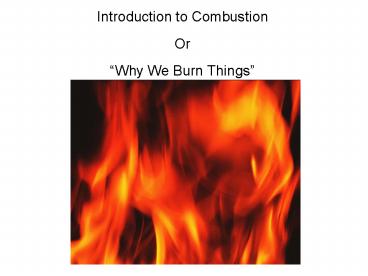Introduction to Combustion - PowerPoint PPT Presentation
1 / 30
Title:
Introduction to Combustion
Description:
2 Nuclear Reactors. Flame Classification. Premixed or Diffusion? Flame. Front. Oxidizer ... What Do We (Engineers) Really Need to know? How Much Energy is Produced? ... – PowerPoint PPT presentation
Number of Views:560
Avg rating:3.0/5.0
Title: Introduction to Combustion
1
- Introduction to Combustion
- Or
- Why We Burn Things
2
Outline
- A Brief history and the importance of fire
- Why Do We Burn Things? (Energy and Power)
- How Do We Burn Things? (Flame Classification,
Anatomy, and Some Cool Flames) - What Do We Need To Know To Burn Things
Effectively? - How Do We Learn The Things We Need To Know ?
3
(No Transcript)
4
(No Transcript)
5
(No Transcript)
6
So, What makes fire so great or Why do we burn
things?
- Consider Filling your car With Gasoline
- Adding 10 Gallons takes about 1 minute
- This is not a particularly shocking or
interesting thing to do!!!
7
But when you do it
Heating Value of Gasoline 43 MJ/kg Density
750 kg/m3 1 Gallon 0.003785 m3
10 Gallons of Gas contains (0.03785m3)(750
kg/m3)(43MJ/m3) 1221 MJ !!!
Pumping this in one minute (60 sec) means that
the POWER is (1221MJ)/(60s) 20.3 MW !!!
To Put that in Perspective, thats 27,280
Horsepower
8
http//www.cpcug.org/user/kjmorris/af-2.html
9
Nimitz Class Aircraft Carrier 1092 Feet Long 252
Feet wide 97,000 TONS 2 Nuclear Reactors
10
Flame Classification
- Premixed or Diffusion?
DIFFUSION Fuel in a sea of air Flame only at
interface
Flame Front
Oxidizer ONLY
Fuel Only
NOTE In most Cases the Flame Front is very Thin
(1 mm or less)
11
A (partially) Premixed Flame.
A Natural Gas Torch
Fuel Lean Region Slightly Less Fuel Than
Required the Deep Blue color Is mostly caused
by excited CH radicals
Fuel Rich Region Slightly More Fuel Than
Required the Blue/Green color Is mostly caused
by excited C2 radicals
12
A Diffusion Flame which should look familiar or
Not
Orange color caused by Soot getting red hot
and radiating
http//microgravity.grc.nasa.gov/sts-107/gallery.h
tml
13
Pros Cons of flame types
- Premixed (e.g. Gasoline Engines)
- A bit Faster burn
- Rather Cleaner
- Must handle mixture with care!
- Diffusion (e.g. Diesel Engines)
- A bit slower burn (takes time to mix first, then
burn) - Typically dirtier (remember the candle soot)
- Ingredients can be abused They wont go off
until you mix them
14
Remember the flame zone from before?
- Heres what we tell you goes on there as
FRESHMEN CH4 2O2 ? CO2 2H2O
15
And heres what REALLY goes on
16
(No Transcript)
17
(No Transcript)
18
(No Transcript)
19
(No Transcript)
20
(No Transcript)
21
(No Transcript)
22
(No Transcript)
23
Flame Anatomy
Flame Zone
Burned Gasses High Temp.
Unburned Gasses Low Temp.
T
Luminous Zone CO Oxidizes to CO2 Most Energy
Release
Preheat Zone large HC molecules break into
smaller ones
Reaction Zone, OH
24
What Do We (Engineers) Really Need to know?
- How Much Energy is Produced?
- What products are produced?
- How Fast Can We Burn it?
- From the above things we can calculate
Temperature and Pressure
- Calorimetry
- GC, Other Chemical analysis, Laser Diagnostics
- Requires knowledge of detailed mechanisms and
physics Laser Diagnostics
25
A typical laser diagnostics set up (probably
PLIF)
http//www.dlr.de/EN-AT/tm/LIF/LIF_Index_ger.htmi
nternalactioncd _framecontent.actionLANGUAGEge
ANONYMOUSyes
26
CH PLIF (top) and OH PLIF (bottom) allow study
of how a flame front is affected by a vortex (by
being stretched by flow turbulence) (Premixed
Flame)
http//www.grc.nasa.gov/WWW/combustion/people/vngu
yen/Plif/Plif.htm
27
Turbulent premixed flame. Single shot OH plif
http//lpc.web.psi.ch/
28
Two Color Mie Scattering Image of a turbulent
diffusion flame
http//inhavision.inha.ac.kr/g2011485/main.html
29
There are Other ways to study combustion For
example through Computer simulations
Turbulent Diffusion flame Simulation (computer
calculation)
All you EE and CS folks out there take note The
VERY Best computers and Programs are just
beginning to be able to handle complex
combustion problems! This is probably the area
where the greatest future developments in the
field will occur.
http//www.stanford.edu/hpitsch/LESExample.html
30
Questions?































